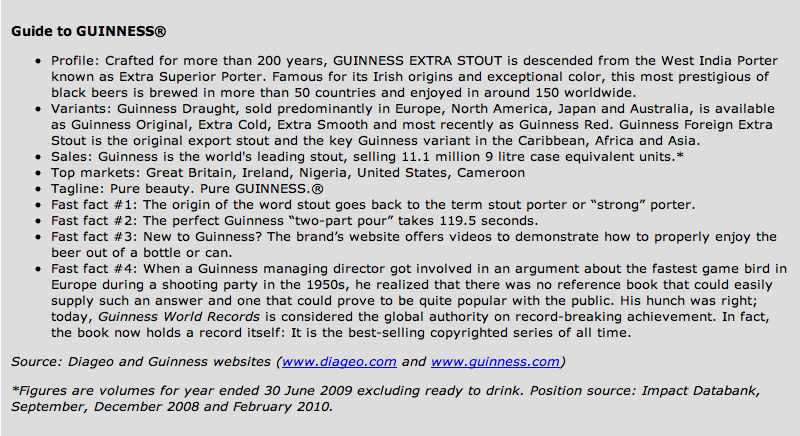![]()
You are welcome to share your thoughts on this article written by Fred Richards, Global Executive Director for Consumer Packaged Goods Executive Creative Director, North America, Interbrand
Hoisting a pint of Guinness beer has become synonymous with celebrating St. Patrick’s Day, “the friendliest day of the year.” What is it about Guinness—this creamy black liquid with froth on top—that makes the brand so unique and enables it to unite the world and turn everyone Irish, if only for a day? Beyond its taste and history, Guinness does a masterful job of managing and leveraging brand equities to generate extreme loyalty among current customers and attract new ones.
I am a Guinness loyalist and, when given the choice, drink a pint of the dark over any other beer. But even I am mystified at the number of people who, on March 17, choose Guinness even if they don’t really like the taste or don’t drink it during the rest of the year. I cannot think of any other brand that commands such a response; sure, we drink champagne on New Year’s Eve, but no one brand has become identified with that holiday the way Guinness has with St. Patrick’s Day.
Brand Excellence, Personified —My Cincinnati cohort, Creative Director Jamey Wagner, cites three reasons why he believes Guinness has achieved and maintained brand excellence—heritage, brand management and unique experience — and I agree. Let’s look at each of these elements in greater detail.
Heritage — Guinness is one of the oldest brands in the world, having just celebrated its 250th birthday. In 1759, Arthur Guinness signed a 9,000-year lease on an abandoned brewery at St James’ Gate, Dublin. It cost him an initial £100 with an annual rent of £45. Although traditional ale was brewed there at first, it wasn’t long before a new dark porter beer was tried and, after its tremendous success, the now famous stout. Guinness’ longevity is quite impressive, especially when you consider how some brands ride the crest of the trend wave and then fall into obscurity and die. Guinness’ romantic heritage also contributes to the fervent devotion of its brand loyalists.
Every Guinness drinker has either been to Ireland’s most famous brewery and eagerly tells stories of their pilgrimage or one day dreams of such a journey. For me, standing outside the St. James’ Gates in Dublin did seem like the culmination of a magical voyage. On the first of my three visits, I experienced a Willy Wonka moment: I felt as though I had won a golden ticket and access to the Promised Land. Standing before the imposing black gates of Guinness’ high, red-brick-walled brewery made me feel like a small boy about to enter a candy store. And the brewery experience itself never disappoints. Some elements are expected: The guide explains the manufacturing process and history, and visitors long for the product sampling at the end of the tour. But Guinness adds a powerful branding element to the tour: As you climb up and up the brewery stairs, learning all manner of fascinating facts and figures, you become a metaphor/surrogate for the product itself. The excitement as you climb is similar to the beer’s bubbles rising inside the glass. When you finally reach the top, you are greeted with a 360-degree view of Dublin and a central bar where you may partake of a pint of Guinness. Tour members from all over the globe meet and greet each other, sharing time-honored traditions and savoring the moment. It is a magical and special experience for first-timers and a reaffirmation for old-timers that important traditions are being preserved for the next generation. The tour truly is a history-evoking, all encompassing, multi-sensory brand experience.
Brand Management — Guinness has stood the test of time, in part, because it has carefully managed its equities and resisted the urge to overextend itself into sub-brands that don’t resonate with its brand promise. Guinness’ equity strategy is simple, yet effective: identify the core brand assets and leverage them across all touchpoints, all of the time. Black as the dominant color, the harp as logo and a unique opening ceremony are all symbols of the elite club to which Guinness loyalists belong. Similar to Apple and Starbucks consumers who flaunt their white headphones or white coffee cups as they walk down the street, brandishing a Guinness bottle or glass conveys a statement of belonging; of understanding the brand at a deep, emotional level.
Not only has Guinness skillfully managed its brand equities over time, it applies them consistently around the globe. Of course, there always will be purists who believe that a pint in Ireland is better than anywhere else in the world – thicker, creamier and better tasting — a fact borne out in Evan McHugh’s 2008 book, Pint-Sized Ireland: In Search of the Perfect Guinness. According to another of my Cincinnati co-workers, Account Leader (and fellow Guinness lover) Will Kladakis, author McHugh travels the country searching for the perfect pint of Guinness. Through his tale, we learn that throngs of beer enthusiasts flock to Ireland every year with the intent to enjoy a Guinness prepared by experts in its native land. Bartenders, locals, and tourists alike all offer advice on exactly where to find the proper pour (and EVERYONE has an opinion).
While I, too, love raising a pint in Ireland, I find that no matter where I am, Guinness delivers on its brand promise…be it in Sydney, Cape Town or Hong Kong. In fact, Interbrand Design Director Rene Chen reports that Guinness is THE “black beer” in Hong Kong and is perceived as a cool, high-end foreign brand served in pubs, bars and clubs. Originally positioned as a masculine brand — Guinness even has a Chinese name, 健力士 (jiang li shi), which means “a very powerful and masculine man” — women in Hong Kong increasingly enjoy Guinness, in part because the brand is perceived as being healthier than other beers.
Unique Experience — The Guinness brand experience drives a visceral, interactive and expressive relationship with its consumers. The visceral relationship manifests itself by the excitement one feels when first encountering this brand; the beer’s color, smell, the sound of its pour. The interactive relationship begins with the all-important opening ceremony: The pint arrives and the consumer…waits. Let me state that again: The consumer waits. The cascade of bubbles within the glass has to settle prior to that first magical sip from the glass; there has to be a perfect separation of liquid to creamy head of bubbles. The pint is inspected for a clean head, the glass is raised to the mouth, a sip is taken and the glass is returned to the countertop and inspected again.
The visceral and interactive relationships comprise a rich, robust brand experience which, when repeated, fosters consumer loyalty and drives an expressive relationship with the brand: If you are loyal to Guinness, you are eager to share the experience with others. In a bar, this relationship becomes obvious when other Guinness consumers subtly acknowledge the ritual first pour and reaffirm their exclusive club membership. (If you belong, you know what I mean.) What truly fascinates me, though, is the number and diversity of Guinness loyalists I meet and talk to. These are not your average “dudes” drinking some fashionable lager from a trendy, over-designed bottle; they are real people of all ages and backgrounds. For example, my grandmother once told me of a trip she made to Ireland with some girlfriends after the passing of my grandfather and how much she and her friends enjoyed spending an evening in the pub drinking Guinness. I was sharing my club membership with a lady of some 80+ years old! From a consumer segmentation perspective, how many brands can boast such a broad demographic?
Jamey Wagner related a similar bonding experience he had at an Irish pub in San Francisco. The bartender was of Irish descent; when asked why she thought Guinness was so popular, she posited that it was due to consumer word of mouth and the love everyone has for “usquebaugh,” which literally means “the water of life.” I couldn’t agree more.
Props to Diageo —Having acknowledged the power of Guinness’ social network to propel the brand to glory, I also must give considerable credit to Guinness and its parent company, Diageo, for getting the beer’s branding recipe precisely right. They make full use of Guinness’ many assets and triggers to engage the consumer: history, storytelling, unique experience, tasteful merchandise and more.
But the transition to brand stalwart has not always been easy. Prior to expanding the beer’s distribution to include supermarkets, Guinness executives had to solve a true marketing conundrum: How do we get our unique experience out of the pubs and into consumers’ homes? How can we replicate the thrill of the opening ceremony if the pour comes from a can or bottle instead of a tap?
Innovate and win —Any brand that hopes to stand the test of time, to remain relevant and grow market share, has to embrace the process of innovation — and Guinness did. It was one of the first beer brands to develop a “widget” inside the can to activate the beer when air pressure punctured it. The technology seemed magical and impossible, but since it delivered on its promise, consumers maintained their trust in the brand. Guinness effectively bridged the gap between pub and home, the opening ceremony was repeated in living rooms around the world, and sales grew apace. Marketing genius!
Whether it’s a freshly poured pint, a unique slender bottle, or a slightly chilled can, holding a Guinness in your hand provides a unique experience that evokes heritage, membership and deep respect for a “real” beer. And with that first sip, you begin to feel that you, too, can be Irish for a few delicious moments. Let’s raise a glass to this masterful brand. Cheers.
About the Author
Fred Richards is Global Executive Creative Director at Interbrand. He has over 20 years expertise in international design, specifically in the “Fast Moving Consumer Goods” category. With a degree in graphic design from Salisbury College in England and a passion for simple design with a brilliant idea, Fred has led Interbrand’s creative work for Cascade, Duracell, Aspirin, Charmin, Aussie and Bounty, among others.
This article was also authored by:
Rene Chen: Creative Director/Interbrand Shanghai
Will Kladakis: Account Leader/Interbrand Cincinnati
Jamey Wagner: Creative Director/Interbrand Cincinnati


